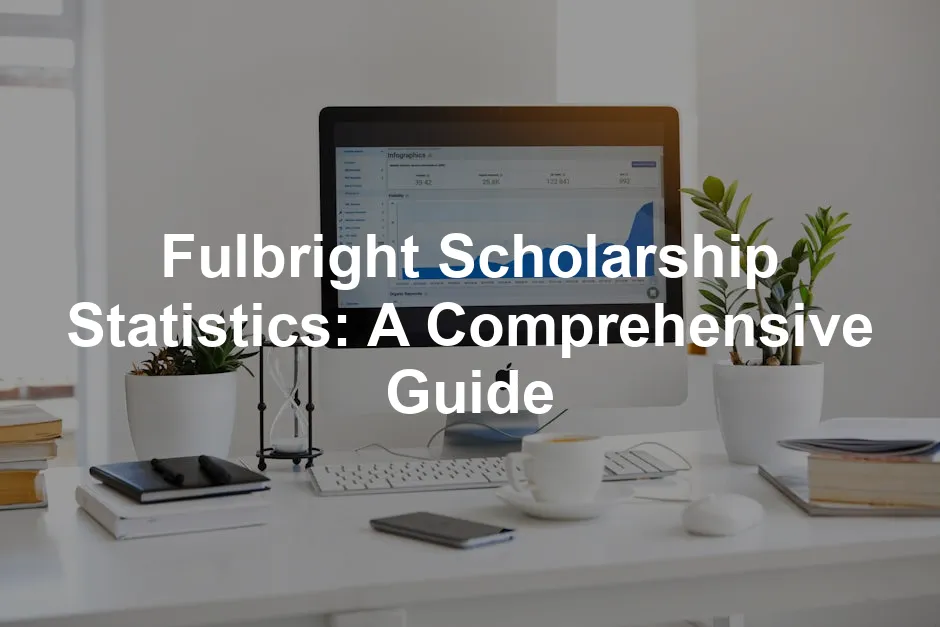Introduction
The Fulbright Scholarship is a prestigious international educational exchange program. Established by the U.S. Congress in 1946, it aims to foster mutual understanding between nations. The program allows U.S. citizens to study, teach, or conduct research abroad while inviting non-U.S. citizens to do the same in the U.S.
Understanding scholarship statistics is crucial for prospective applicants. It helps them navigate the complex world of applications, acceptance rates, and institutional performance. For instance, knowing the trends in application numbers can inform decisions on where to apply. Additionally, awareness of acceptance rates can guide candidates in crafting competitive applications, tailored to specific countries or institutions.
This article provides a comprehensive analysis of Fulbright Scholarship statistics. We will cover various aspects, including application trends, acceptance rates, and the top-producing institutions. By the end of this guide, prospective applicants will have a solid foundation to enhance their chances of success in the Fulbright program.

Understanding Fulbright scholarship statistics is essential for prospective applicants. Fulbright Scholarship statistics can help in navigating the application process effectively.
Get ready to dive into the numbers and trends that can shape your Fulbright experience!
Overview of the Fulbright Program
What is the Fulbright Program?
The Fulbright Program’s mission is to promote educational exchange and cultural understanding. It provides grants for study, teaching, and research opportunities in over 160 countries. The program consists of two primary components: the U.S. Student Program and the U.S. Scholar Program.
The U.S. Student Program is designed for recent graduates and young professionals. It allows them to undertake individually designed study or research projects abroad. On the other hand, the U.S. Scholar Program targets faculty and experienced professionals, enabling them to teach or conduct research overseas.

Global Reach
The Fulbright Program boasts a remarkable global footprint. It operates in more than 160 countries, with thousands of grants awarded annually. In the 2023-2024 cycle, approximately 4,000 grants were made available worldwide. This extensive reach highlights the importance of cultural exchange in fostering global understanding.
Participants engage with diverse communities, sharing experiences and perspectives. This interaction not only enhances individual growth but also strengthens international ties. The impact of such exchanges extends beyond personal development, contributing to a more interconnected world. Through the Fulbright Program, participants become cultural ambassadors, promoting understanding and collaboration across borders.
And speaking of travel, if you’re planning to study abroad, you might want to document your adventures! A Travel Journal for Study Abroad can be a great way to capture all those unforgettable moments and reflections. Plus, it gives you something to look back on when you’re old and gray!

Fulbright U.S. Student Applicant and Grantee Statistics
Application Trends
Annual Applications
In recent years, the Fulbright U.S. Student Program has seen fluctuations in application numbers. For the 2023-2024 cycle, 4,166 applications were submitted. That’s a 5% decrease from the previous year. It seems applicants are adjusting to the ebb and flow of global events.
The regional breakdown is quite intriguing. Europe and Eurasia dominate the scene, accounting for about 62% of applications. That’s roughly 3,000 hopefuls eyeing opportunities in the land of croissants and castles! East Asia and the Pacific follow with 14% of applicants, while the Western Hemisphere holds 11%.
Interestingly, since 2021-2022, applications have generally decreased. However, Sub-Saharan Africa is the exception, showing growth from 215 to 228 applications. It’s like that underdog in a movie who suddenly shines at the end!

Acceptance Rates
General Acceptance Rates
Now, let’s discuss the ever-important acceptance rates. From 2021 to 2024, the overall acceptance rate has averaged around 18%. However, it dipped to 13% during the 2021-2022 cycle. This was primarily due to the COVID-19 pandemic increasing applications while grants were reduced.
In the following cycles (2022-2023 and 2023-2024), the acceptance rate bounced back to approximately 21%. This indicates that the program is stabilizing, and applicants are finding more success once again.

Country-Specific Acceptance Rates
Diving deeper into acceptance rates by country reveals a startling array of competitiveness. If you’re eyeing the United Kingdom, brace yourself! With only a 4% acceptance rate, it’s among the most competitive. Australia isn’t far behind at 7%, and Ireland and New Zealand both sit at 8%.
But don’t lose hope just yet! Some countries have a much more welcoming atmosphere for Fulbright hopefuls. For instance, Zimbabwe and Vanuatu boast a remarkable 100% acceptance rate, though they receive far fewer applications. It’s a classic case of quality over quantity. So, if you’re looking for a better shot, consider these hidden gems!
Overall, understanding these trends and rates is crucial for crafting a competitive application. Knowing where to focus your efforts can make all the difference. So, here’s to aiming for the stars and landing among the top grant recipients!

Country-Specific Insights
Top Countries for Applications and Grants
When it comes to the Fulbright Scholarship, some countries stand out like a sore thumb on a well-groomed hand! The United Kingdom leads the charge, receiving a whopping 1,057 applications on average from 2021-2024. Germany follows suit with 287 applications, while the Netherlands, Spain, and Taiwan each attract a healthy number of hopefuls, with 209, 203, and 158 applications, respectively. These countries not only see high application rates but also have a fair share of grants awarded, making them prime destinations for aspiring Fulbright participants.

Least Competitive Countries
Conversely, some countries offer less competition and higher success rates. For instance, Zimbabwe and Vanuatu have been shining stars with a 100% acceptance rate, although they receive only 1-2 applications per year. Other nations with a lower number of applications, like Dominica and Grenada, also present favorable odds for applicants. The lesson? Sometimes, less is more! If you’re looking for a better shot at securing a Fulbright grant, consider these hidden gems. They may not have the spotlight, but they sure have the winning numbers!
Impact of the Fulbright Program
Career and Educational Impact
Transformative Experiences
The Fulbright Program has a knack for transforming lives! A stunning 97% of alumni reported that their experiences were professionally transformative. Imagine being catapulted into an international network of scholars, artists, and innovators. It’s like being handed a golden ticket to a world of opportunities! This program paves the way for enhanced career trajectories and opens doors that were previously locked tight.

Academic Contributions
Fulbright U.S. Scholars are not just globe-trotters; they’re also education trailblazers! In fact, they developed a staggering 275 new courses at host institutions. These contributions impact thousands of students globally. U.S. Scholar alumni have advised or taught over 80,372 students through various workshops and seminars, making a lasting mark on academia. This isn’t just a program; it’s a movement for educational advancement!
Global Networks and Connections
The Fulbright Program is a masterclass in networking! A fantastic 95% of participants reported widening their research networks through this experience. The connections formed during these grants often lead to collaborative projects, research partnerships, and lifelong friendships. Moreover, 73% of scholars embarked on new internationalization efforts after their Fulbright experience. Talk about planting the seeds for a global community! Fulbright alumni return home not just with stories, but with rich ties that span continents.

Top Producing Institutions
Overview of Institutions
In the world of Fulbright Scholarships, some institutions consistently shine brighter than others. These “top-producing institutions” are universities that have garnered significant recognition for their excellence in producing Fulbright grantees. Their significance extends beyond mere numbers; they symbolize a commitment to fostering global engagement and educational exchange.
Being affiliated with a top-producing institution can be a game-changer. It often indicates a robust support system for applicants, including dedicated advisors and resources tailored to navigating the complex application process. For aspiring Fulbright candidates, this can mean fewer hurdles and a better chance of success. The collaborative environment often found at these institutions encourages students to pursue ambitious projects that align with the Fulbright mission of promoting cultural exchange.

Statistics on Top Producers
According to the latest data, several institutions have emerged as leaders in producing Fulbright grantees. Here’s a snapshot of some of the top producers and their impressive award counts:
- University of Southern California: 23 awards
- University of California, Berkeley: 20 awards
- University of Illinois at Urbana-Champaign: 18 awards
- University of Florida: 16 awards
- George Washington University: 15 awards
- University of Michigan: 15 awards
- New York University: 14 awards
These statistics reflect a commitment to international education and showcase the diverse fields of study represented by awardees from these institutions. Notably, institutions like the University of Southern California have consistently ranked high, demonstrating their effective support for students aiming for Fulbright opportunities.

Furthermore, many of these top-producing institutions regularly hold workshops and provide mentorship for applicants. This proactive approach to preparing students is crucial in an increasingly competitive landscape. Not only do they boost their own numbers, but they also foster a culture of excellence that encourages students to think globally.
Influence on Future Applicants
Being associated with a top-producing institution carries weight in the application process. It can enhance an applicant’s profile and signal to selection committees that they come from a supportive and resource-rich environment. This affiliation often provides access to experienced mentors who can guide candidates through the nuances of crafting strong proposals.
Moreover, the prestige associated with these institutions may lead to a more extensive network of Fulbright alumni and faculty, offering valuable connections and insights. This network can be instrumental when seeking advice, sharing experiences, or even collaborating on projects after receiving the award.
In conclusion, aspiring Fulbright applicants should consider the advantages of applying through these top-producing institutions. The combination of institutional support and a demonstrated history of success can significantly increase their chances of securing a Fulbright award, paving the way for transformative international experiences.

Preparing a Competitive Application
Key Considerations
Understanding Requirements
When applying for a Fulbright Scholarship, understanding the specific requirements for different countries and programs is paramount. Each destination has unique criteria, ranging from academic qualifications to language proficiency. Research is your best friend here. Pay close attention to what each country values in applicants. This knowledge can shape your application and improve your chances of acceptance.

Application Strategies
Crafting a compelling application is an art. Start by aligning your personal goals with the mission of the Fulbright program. Your proposal should reflect a clear connection between your academic pursuits and the cultural exchange the program promotes.
Don’t forget to showcase your research! Highlight how your project contributes to both your field and the host community. Tailor your application to demonstrate your commitment to mutual understanding and collaboration.
Additionally, seek feedback from mentors or past Fulbright recipients. They can offer invaluable insights that can help refine your application. It’s also wise to participate in workshops that focus on application strategies. This proactive approach can make your submission stand out in a sea of talented candidates.
In summary, understanding requirements and employing effective strategies are crucial for a successful Fulbright application. By being informed and prepared, you can significantly enhance your chances of joining this esteemed program and experiencing the world in a transformative way.

Resources for Applicants
Navigating the Fulbright application process can feel like trying to get through a maze blindfolded. But fear not! There are plenty of resources to help you find your way and create a standout application.
First, check out mentorship programs. These initiatives pair prospective applicants with experienced Fulbright alumni. Having someone who’s been through the process can make all the difference. They’ll offer insights on what worked for them, what didn’t, and how to craft a compelling narrative.
Next up, workshops! Many universities and organizations hold workshops focused on the Fulbright application process. These sessions often cover everything from writing an impactful personal statement to understanding the nuances of project proposals. Don’t miss out on these opportunities to learn from experts and get feedback on your application drafts.
Additionally, application guides are your new best friend. Many resources provide step-by-step instructions on how to complete the application. These guides often include tips for specific countries or programs, outlining what selection committees look for.
Lastly, the official Fulbright website is a treasure trove of information. It features updated statistics, eligibility criteria, and deadlines. Bookmark it and refer to it often to stay informed.
By leveraging these resources, you’ll approach your application with confidence and clarity. Remember, every successful Fulbright applicant started as an unsure hopeful. With the right guidance and preparation, you can turn that uncertainty into a resounding “yes”!

Conclusion
In summary, understanding Fulbright Scholarship statistics is essential for prospective applicants. The insights gained from acceptance rates, application trends, and competitive regions can significantly enhance your chances of success. For instance, knowing that the overall acceptance rate hovers around 18% helps set realistic expectations. It also highlights the importance of tailoring your application to specific countries or institutions that align with your goals.
Moreover, the data reveals the transformative impact of the Fulbright experience. Alumni report profound benefits, such as enhanced career trajectories and expanded global networks. This underscores the scholarship’s value beyond mere academic achievement—it’s a life-changing opportunity.
So, as you prepare your application, keep these statistics in mind. Utilize them to refine your approach and strengthen your proposals. Remember, the Fulbright program is not just about receiving a grant; it’s about fostering mutual understanding and building bridges across cultures.
Take a moment to reflect on how this prestigious program can shape your personal and professional growth. Embrace the challenge, leverage the resources available, and aim high. Your journey toward a Fulbright Scholarship could be the key to unlocking a world of possibilities!
Frequently Asked Questions
1. What is the average acceptance rate for the Fulbright Scholarship?
The average acceptance rate for the Fulbright Scholarship has fluctuated in recent years. From 2021 to 2024, the overall acceptance rate was approximately 18%. However, it dipped to 13% in the 2021-2022 cycle due to a surge in applications during the pandemic. In subsequent cycles, the acceptance rate rebounded to around 21%, indicating a stabilization of the program.
2. How many applications are received annually?
Each year, the Fulbright Program receives approximately 4,000 applications. For the 2023-2024 cycle, there were 4,166 applications, reflecting a 5% decrease from the previous year. The majority of applications come from Europe and Eurasia, representing about 62% of the total.
3. Which countries are the most competitive for Fulbright Scholarships?
Some countries are notoriously competitive for Fulbright Scholarships. The United Kingdom, for example, has an acceptance rate of only 4%, making it one of the toughest countries to secure a grant. Other competitive countries include Australia (7%) and Ireland and New Zealand (8%). In contrast, countries like Zimbabwe and Vanuatu boast acceptance rates of 100%, though they receive fewer applications.
4. What resources are available to help with the application process?
Numerous resources can assist in the Fulbright application process. Key options include mentorship programs that connect applicants with alumni, workshops that provide valuable insights on application strategies, and guides available on the official Fulbright website. Staying informed and seeking support can significantly enhance your application’s competitiveness.
And while you’re preparing for your journey, make sure you’re equipped with the right tools! A pair of noise-cancelling headphones can make those long flights a lot more enjoyable by blocking out the world and letting you focus on your favorite tunes or podcasts!
Please let us know what you think about our content by leaving a comment down below!
Thank you for reading till here 🙂
All images from Pexels




